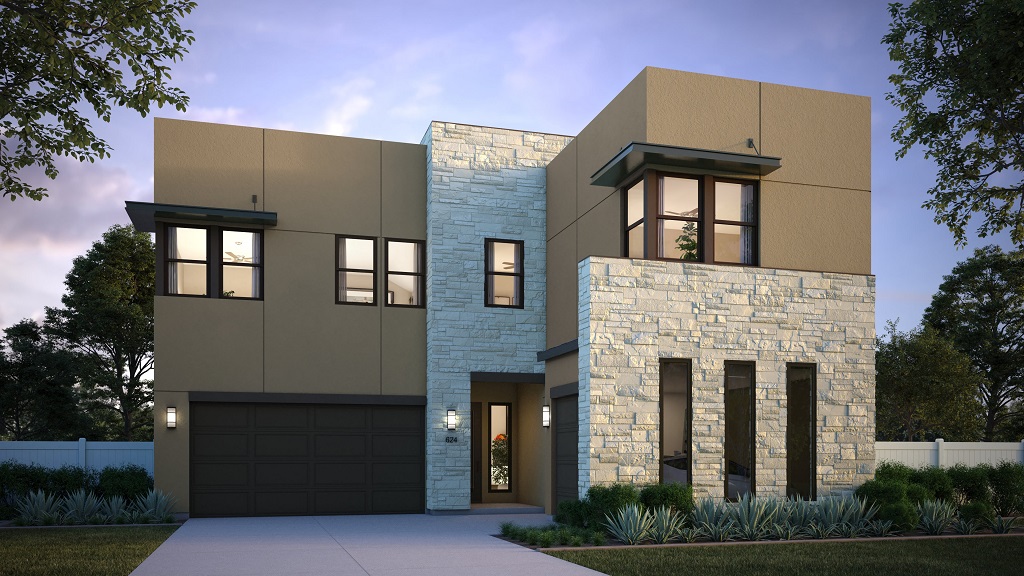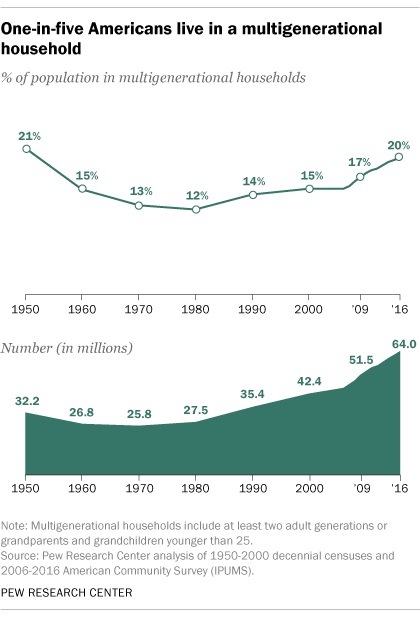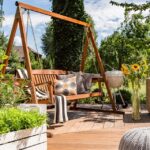The main photo is courtesy of Lennar and is the Residence X model, part of the Alta collection in their 3 Roots, San Diego, CA community.
Multigenerational living is a cultural tradition in many societies and more Americans have been adopting this living arrangement, as they learn more about the overall benefits for both younger and elder generations.
The hit television series Frasier, was perhaps the best comedic example of multigenerational living as Frasier and his father, Martin, humorously and often poignantly clashed due to their obvious differences. Similarly, The Waltons, a popular true-life Depression Era family drama that aired in the 70’s, illustrated the benefits and joys of close family ties in a rural Virginia town, for a family with seven children, two parents and two paternal grandparents in residence.
Families who live in close proximity of each other can foster a sense of familial community, learn to resolve family issues in a more constructive and timely manner, and are better able to pass on constructive wisdom and encouragement from generation to generation, helping to preserve family heritage and pride.
The US is Trending Back Toward Multigenerational Households
1 in 5 American Households are Multigenerational
In 1950, 21% of US households were multigenerational, according to a 2016 study by the Pew Research Center. In other words, at least two generations of related adults, lived under the same roof. This may have been parents with their adult children, parents with their parents or parents with their grandchildren.
Nevertheless, the trend began to shift as 1980 saw a decline in joint family living to only 12%. Through the years, for reasons that many believe were purely economical, multigenerational family living up-ticked to 18.1% in 2012 and then again to 20% in 2016. After almost 70 years we are trending back to families living together for reasons that may prove economically and mentally beneficial.
Advantages of Multigenerational Living
Cost-Savings
Multigenerational households have an economic advantage since household expenses can be divided amongst more residents. For older generations living on a fixed income, this is especially beneficial, as their cost of living and net income may be inversely proportional. Sharing expenses for a joint household relieves the economic stress of parents, who need to be concerned with educational costs and other cash outlays that result from raising children.
For elderly members of the family, living in a joint family home can be significantly more cost-effective when compared to senior housing communities. Cost savings can then be used for supplemental healthcare services.
Division of Labor & Responsibilities
As parents and grandparents age, daily home maintenance and other tasks that involve physical fitness can become daunting or downright dangerous. Activities such as changing a light bulb or painting a fence may be impossible for those with diminished manual dexterity or failing cardiac or respiratory health. Even daily activities such as vacuuming, cleaning bathrooms or kitchens can become a hardship for anyone with arthritic conditions or reduced motor skills.
Multigenerational living allows a division of responsibilities for those most able to perform certain tasks. Older family members can still perform activities that benefit the household, such as child care, family finances and any other activities, where they play an assist role to supplement more physically challenging projects.
Better Family Relationships
Although many families would disagree with the statement that multigenerational living arrangements improve family relationships, the data and anecdotal evidence would prove this to be true. Instilling good values, passing along cultural heritage, rites, rituals ceremonies and traditions are all important roles of grandparents and other family elders. Understanding the family history and beliefs, also helps the harmonization of family as sharing these practices strengthens traditions and creates positive bonds and behaviors within the home.
Improved Safety & Health
Seniors are less likely to be left alone for prolonged periods of time. Conversely, young children have grandparents waiting at home for them after school. Out-of-town travel can be handled more effectively as someone is always home to monitor the homestead. Well planned Aging-In-Place remodels can add an additional layer of safety and convenience for grandparents.
A study published in the April 2018 issues of SSM – Population Health concluded that healthy people living in two-generation households have longer survival rates than healthy people living on their own. Informal, regular interactions can be associated with greater health and happiness. In short, well-functioning “multigen” households have more people looking after each other, including the grandchildren who can intuitively learn to emulate the parenting instincts of their elders.
Challenges of Multigenerational Living
There is no doubt that living in a multigenerational household is rife with challenges. However, ample forethought and planning can reduce friction, conflict and the desire to retreat to separate homes, if managed correctly. Builders and home designers are aware of these issues and are proactively delivering solutions to mitigate these concerns, with features that address privacy first and foremost.
The Need for Privacy
There is no doubt that every couple, or individual for that matter, needs some, private time within their personal space. Having a houseful of relatives, day after day, can seem overwhelming for most people. However rules of engagement are a necessity to insure that every family member has personal, private space and that boundaries are respected. Adequate privacy can be defined in terms of: space, sound, secured doors, private entrances, isolated utilities, and even separate garages.
Ownership & Financial Issues
Avoid legal complications by addressing ownership and financial issues upfront. Failure to legalize the deed, ownership percentages and financial arrangements will lead to issues should the arrangement prove untenable. These matters are especially important to resolve when involving multiple adult siblings who have unequal levels of investment and involvement in the main multigenerational home (e.g. typically the parent’s lifelong home).
Clearly defining how recurring household expenses will be allocated upfront is also critical for setting expectations and harmonizing the extended household’s finances. Having a separate living structure like an ADU (Accessory Dwelling Unit), with isolated utilities (e.g. water, electricity, kitchen, and laundry) is one way to cleanly address this issue.
Differing Lifestyles and Conflicting Decor Taste
Adjusting to a timetable and to activities that suit both the older and younger generations could be an issue for family members. Waking up at 5am for breakfast or retiring at 7pm is not for everyone, so adjusting to differing lifestyles, including active socializing at home, will need to be addressed to prevent conflicts and impacts on everyone.
Examples of Multigenerational Living
A Multigenerational Case Study: 4 Generations Living in Harmony
Tracey Clifton, a realtor from Texas, has become a staunch advocate for multigenerational living as she shares her stories on her YouTube channel. Years ago, Tracey and her family moved back to her childhood home to aid in the care of her paternal grandmother, who had returned to live in the home with Tracey’s parents.
As her Dad has just recently retired and was set to journey on an RV driving tour with Tracey’s Mom, tragedy struck. Grandma’s condition had worsened and would need around the clock care, which meant that Tracey’s parents would need to postpone their long awaited retirement plans.
When Tracey and her husband heard the disheartening news they proposed an alternative solution. They not only would move into the home to help with the care of Grandma, thus allowing her parents to hold on to their travel plans, but they also built a fully functional 2BR/2BA ADU unit, outfitted for Aging-In-Place. The rest, as they say, is history.
Years later, regarding her multigenerational experience, Tracey proudly attests:
“I wouldn’t trade it for the world!”
She and her husband have reared four well-adjusted, responsible children who have developed a genuine reverence for family. Their extended family home has become an oasis for both their children and their friends, who see it as a trusted place where they can be themselves. Her parents have been able to enjoy their retirement as originally planned, while Grandma’s health needs were fulfilled for over 10 years until her passing. Tracey’s family continued their multigenerational outreach when Tracey’s maternal grandmother would later move into the household, as well. To date, they continue to make it work and get better with time!
A Multigenerational Case Study: Choosing Between Building & Buying
Nick Good, a real estate agent from Plano, Texas, shares the approach he and his family are taking for choosing their next multigenerational home in the video below. He specifically reviews which features to consider when deciding between Building a New Multigenerational Home or Buying an Existing Home.
With his mother-in-law already living with his family, plus the likelihood of his parents moving into their next home, ample size is his number one priority (6,500 sq. ft. or more). His second priority is ensuring that all parties have sufficient privacy, including planning for his children as they grow older.
Regarding benefits, Good and his wife view assistance with childcare as by far the top benefit of this type of living arrangement. Joint family living is not just about convenience but the assurance that your children are in good hands when you are not around. He also believes close proximity to the grandkids will strengthen the grandparents’ health and well-being.
Functional Multigenerational Floorplans
A number of national and regional builders have been expanding their offerings of Multigenerational Housing Floorplans, as demand for flexible living arrangements has continued to grow. In many cases these plans include in-law suites or separate living quarters within the main home, including separate garages.
The ideal features of a comprehensive multigenerational home would include:
- Ample square footage, e.g. 4,500 sq. ft. or larger
- Large common areas, e.g. kitchen, great room, dining area, outdoor
- Private In-Law Apartment (attached or detached):
- Private Entrances from outdoor, garage and inside main house
- Kitchenette or Full Kitchen
- Large Enough Bathroom
- Laundry Facilities
- Wheelchair Accessible
- ADA compliance, e.g. space allowances & reach ranges
- Separate Utilities
- Extra Sound Insulation
DR Horton
DR Horton, the largest home builder in the US, offers Multi-Gen Floor Plans, touted as “Two Homes Under One Roof” with in-law suites. Their multigenerational floor plans offer a separate living space with bedroom, kitchenette and exterior entrances. If you are interested in one of their communities, inquire if they offer a multigen floor plan for that specific locations.
Video courtesy of Tyler Watson.
Hovnanian Homes
Hovnanian Homes, another leading American builder, offers multigenerational floorplan features packaged as Extra Suite, which offers amenities such as: separate private suites, kitchenettes, and dedicated entrances.
Lennar
Based in Miami, Lennar Corporation is the second largest home builder in America and services over 27 US markets. The company entered the multigenerational home market in 2011 after the financial crisis, as they responded to the trend of families needing to care for their aging parents. Between 5-10 percent of all Lennar homes include a “Next Gen“ suite, or separate apartment for multigenerational living. In Phoenix, Arizona, Lennar’s most popular market for multigenerational living, 25 percent of total sales include a Next Gen suite.
Lennar Case Study
DTJ Design
Seth Hart, a designer with DTJ Design, based in Boulder, Colorado, discusses his well thought-out flexible design for a multigenerational plan with Pro Builder in the video below. Two key requirements drive talented designers like Hart when designing a multigen floorplan:
- Flexibility: a well-designed multigenerational home will be able to handle many different living situations and arrangements throughout its lifespan
- Privacy: a well-designed multigenerational home will enable large families to live together and still have privacy
Some notable features of this particular plan includes: multiple private entrances to the in-law suite; a private outdoor area; and a double-wall with additional sound insulation between the suite and main house.
Video courtesy of Pro Builder.
What to Consider When Deciding on a Multigenerational Home
Having listened to and spoken with several people currently living in multigenerational homes, we offer some key words of advice on how to foster a happy and thriving multigenerational home:
- Get everyone to commit to making this lifestyle work
- Put in rules per “household” from the onset to set expectations of mutual respect
- Tell others how you feel; being a martyr is not healthy
- Adult children, at times, will need to treat the grandparents like teenagers for their own protection & safety
- Grandparents will need to provide more parenting for grandchildren than they are normally accustomed
- Grandchildren will need to accept more responsibility, especially with helping provide care for grandparents
- Acknowledge Trade Offs & Be Thankful for Them:
- Everyone will gain some freedom, while losing some freedom
- Everyone will receive more help, while needing to give more help
When speaking with Tracey Clifton, we could tell that she was most grateful for the positive effect that her multigenerational experience has had on her children. Specifically, we could “hear” her smile when describing how her own kids have taken on parenting traits of their own through osmosis. She ended our call with this proud acknowledgement:
“We are doing something hard – raising good kids to become good citizens”
Additional Multigenerational Home Resources
What Are the House Ownership Options When Parents and Adult Children Live Together?
What You Should Know Before Building an In-Law Suite
Staying Put or Moving On: Where and How We’ll Live as We Grow Older
Generations United, a Non-Profit that Promotes Intergenerational Living
Related Articles
Why Homeowners Should Invest in a Prefab ADU
The New American Remodel 2021: Sustainable & Energy Efficient Beauty
The New American Home 2021: 10 Exceptional Products
How to Apply Transformable Interior Design to Your Home
Financing Your Home Renovation with Noah Shared Equity Contracts
Aging in Place Technology for Today and Tomorrow
| Purgula is reader-supported. When you click on links to other sites from our website, we may earn affiliate commissions, at no cost to you. If you find our content to be helpful, this is an easy way for you to support our mission. Thanks! Learn more. |








